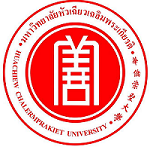Please use this identifier to cite or link to this item:
https://has.hcu.ac.th/jspui/handle/123456789/4645Full metadata record
| DC Field | Value | Language |
|---|---|---|
| dc.contributor.author | 李卓玲 | - |
| dc.contributor.author | Li Zhuoling | - |
| dc.contributor.author | 刘玲 | - |
| dc.contributor.author | Liu Ling | - |
| dc.contributor.other | Huachiew Chalermprakiet University. College of Chinese Studies. Graduate Student | en |
| dc.contributor.other | Nanning Normal University | en |
| dc.date.accessioned | 2025-10-12T14:03:23Z | - |
| dc.date.available | 2025-10-12T14:03:23Z | - |
| dc.date.issued | 2024 | - |
| dc.identifier.citation | วารสารวิชาการภาษาและวัฒนธรรมจีน 11, 1 (มกราคม-มิถุนายน 2567) : 353-370. | en |
| dc.identifier.uri | https://has.hcu.ac.th/jspui/handle/123456789/4645 | - |
| dc.description | สามารถเข้าถึงบทความฉบับเต็ม (Full Text) ได้ที่ : https://so02.tci-thaijo.org/index.php/clcjn/article/view/261434/180641 | en |
| dc.description.abstract | 近年来,中国与泰国的联系日益密切,与中国构建了互利互惠的合作关系,汉语学习的需求也随之增加,在泰国形成了“汉语热”的现象,汉语成为泰国除英语之外的第二大外语。通过调查发现,泰国的汉语学习者喜欢观看中国的影视作品,纪录片也是其中之一。其中纪录片《舌尖上的中国》于 2012 年首播之后,被翻译成英语、泰语、法语等在海内外传播,成为中国现象级的饮食文化类纪录片。现阶段,汉语在泰国的学习需求日益增大,为汉语学习者提供更多适合且有趣的学习方式,是目前的迫切所需。《舌尖上的中国》作为在国内外具有深远影响的现象级别纪录片,与其他的影视资源一样具有教学价值。本文主要从教学目标、教学对象、教学内容、教学原则这四个方面,对《舌尖上的中国》应用于泰国汉语学习者提出教学策略,为该纪录片应用于汉语教学提供一些参考和借鉴。 | en |
| dc.description.abstract | In recent years, the relationship between China and Thailand has become increasingly close, and a mutually beneficial cooperative relationship has been established with China. The demand for Chinese learning has also increased. In Thailand, the phenomenon of "Chinese fever" has formed, and Chinese has become Thailand's No. 1 language besides English. Two foreign languages. The survey found that Chinese language learners in Thailand like to watch Chinese film and television works, and documentaries are one of them. Among them, the documentary "A Bite of China" was first broadcast in 2012, and was translated into English, Thai, French, etc. and spread at home and abroad, becoming a phenomenon-level food culture documentary in China. At this stage, the demand for learning Chinese in Thailand is increasing day by day. It is an urgent need to provide more suitable and interesting learning methods for Chinese learners. This article mainly provides teaching strategies for utilizing the documentary "A Bite of China" in Chinese language instruction for Thai learners. It examines teaching objectives, target learners, teaching content, and teaching principles to offer insights and recommendations for incorporating this documentary into Chinese language teaching specifically for Thai learners. The aim is to provide valuable references and insights for the application of this documentary in Chinese language instruction for Thai learners. | en |
| dc.language.iso | zh | en |
| dc.publisher | มหาวิทยาลัยหัวเฉียวเฉลิมพระเกียรติ | en |
| dc.subject | สารคดี | en |
| dc.subject | Documentary | en |
| dc.subject | อาหารจีน | en |
| dc.subject | Chinese food | en |
| dc.subject | อิทธิพล (วรรณกรรม ศิลปกรรม ฯลฯ) | en |
| dc.subject | Influence (literature, art, etc.) | en |
| dc.subject | ภาษาจีน -- การใช้ภาษา | en |
| dc.subject | Chinese language -- Usage | en |
| dc.subject | 中国菜 | en |
| dc.subject | 影响 (文学 艺术 等) | en |
| dc.subject | 汉语 -- 语言使用 | en |
| dc.subject | ภาษาจีน -- การศึกษาและการสอน -- ไทย | en |
| dc.subject | 汉语 -- 学习和教学 -- 泰国 | en |
| dc.subject | Chinese language -- Study and teaching -- Thailand | en |
| dc.title | 《舌尖上的中国》应用于泰国汉语学习者的教学策略分析 | en |
| dc.title.alternative | Analysis of the teaching strategies of"A Bite of China"applied to Chinese learners in Thailand | en |
| dc.type | Article | en |
| Appears in Collections: | College Of Chinese Studies - Articles Journals | |
Files in This Item:
| File | Description | Size | Format | |
|---|---|---|---|---|
| Analysis-of-the-teaching-strategies-of-A-Bite-of-China-applied-to-Chinese-learners-in-Thailand.pdf | 137.3 kB | Adobe PDF | View/Open |
Items in DSpace are protected by copyright, with all rights reserved, unless otherwise indicated.
